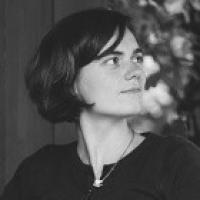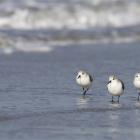Migrating birds play a starring role in the history of conservation in the Wadden Sea, an intertidal zone stretching along the coasts of the Netherlands, Germany, and Denmark from Den Helder to Esbjerg. Both early, amateur conservation efforts and later, institutionalized ones in the 1960s focused on these birds (Wöbse and Ziemeck 255–56; Wöbse 2017, 207). The most radical measures for conservation taken in the Wadden Sea—namely, excluding people from designated areas—were taken to protect birds (Wöbse 2013, 172). Birds are also part of the reason why the Wadden Sea is beloved and successful as a conservation area: they attract many visitors, especially around the season of the birds’ migrations in spring and autumn, which conservation societies encourage by hosting events.
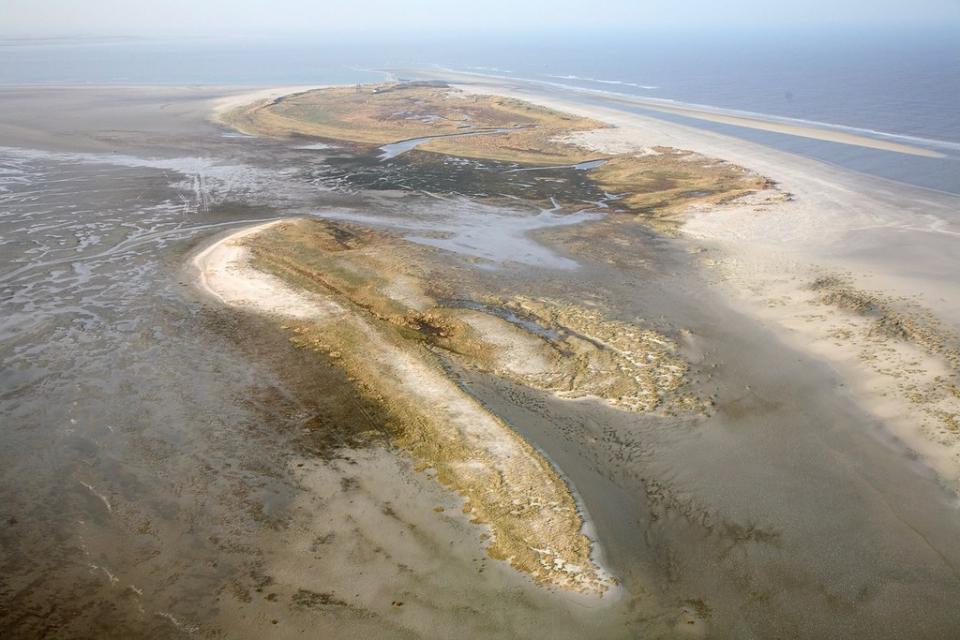
Photograph by Bas Kers, 2006.
Accessed via Flickr on 3 March 2021. Click here to view source.
 This work is licensed under a Creative Commons Attribution-NonCommercial-ShareAlike 2.0 Generic License.
This work is licensed under a Creative Commons Attribution-NonCommercial-ShareAlike 2.0 Generic License.
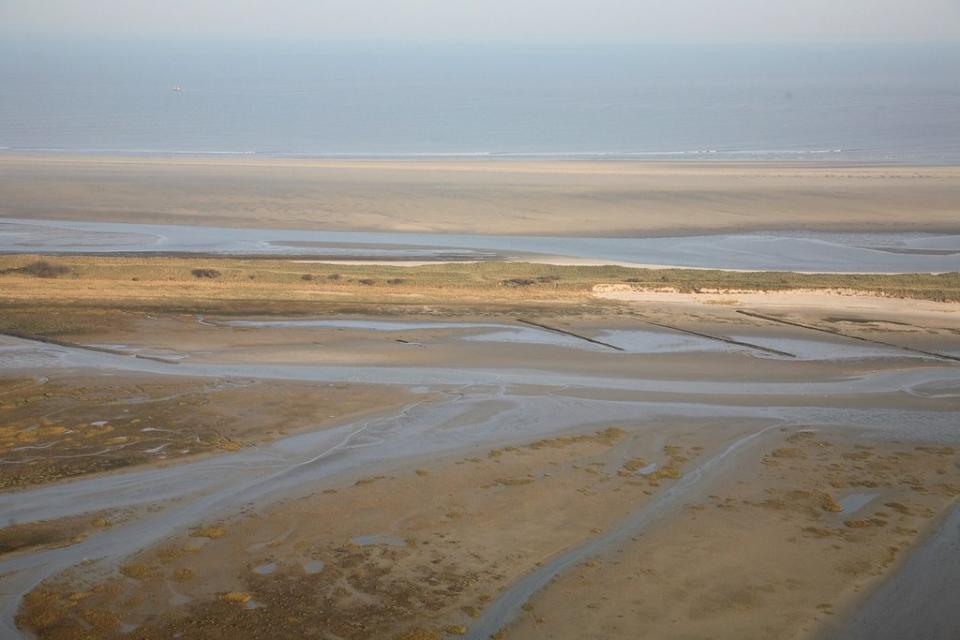
Photograph by Bas Kers, 2006.
Accessed via Flickr on 3 March 2021. Click here to view source.
 This work is licensed under a Creative Commons Attribution-NonCommercial-ShareAlike 2.0 Generic License.
This work is licensed under a Creative Commons Attribution-NonCommercial-ShareAlike 2.0 Generic License.
Aerial photograph of Rottumeroog (right) and Rottumerplaat (left) in the Wadden Sea, 2006.
The Wadden Sea is a unique site, and one that raises particular questions about conservation, partly due to its significance for migrating birds. For much of the year, the Wadden Sea lacks many of the species it is protected for. It is a site in sequential waiting: for the redshank (Tringa totanus) to breed in springtime, the red knot (Calidris canutus) to feed in autumn, and the sanderling (Calidris alba) to overwinter. The Wadden Sea’s physical constitution reflects its changing population: it too shifts shape with each coming ebb and tide, as sand and silt are removed from one place and deposited elsewhere, and its islands migrate slowly eastwards. Today, the Wadden Sea’s changing nature is exacerbated by rising sea levels and changes in the behavior and distribution of species as a result of climate change.
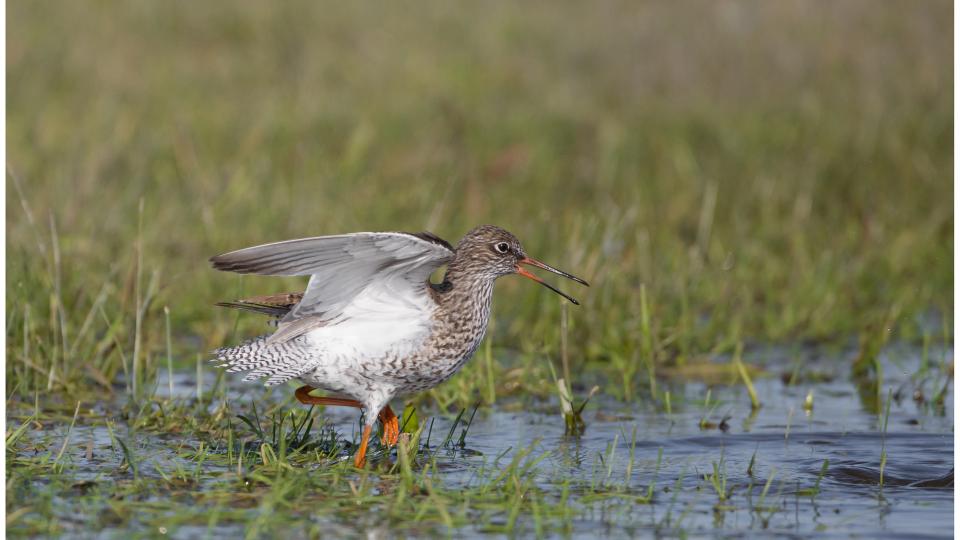
Common Redshank (Tringa Totanus)
Common Redshank (Tringa Totanus)
Photograph by Martha de Jong-Lantink, 2017.
Accessed via Flickr on 3 March 2021. Click here to view source.
 This work is licensed under a Creative Commons Attribution-NonCommercial-NoDerivs 2.0 Generic License.
This work is licensed under a Creative Commons Attribution-NonCommercial-NoDerivs 2.0 Generic License.
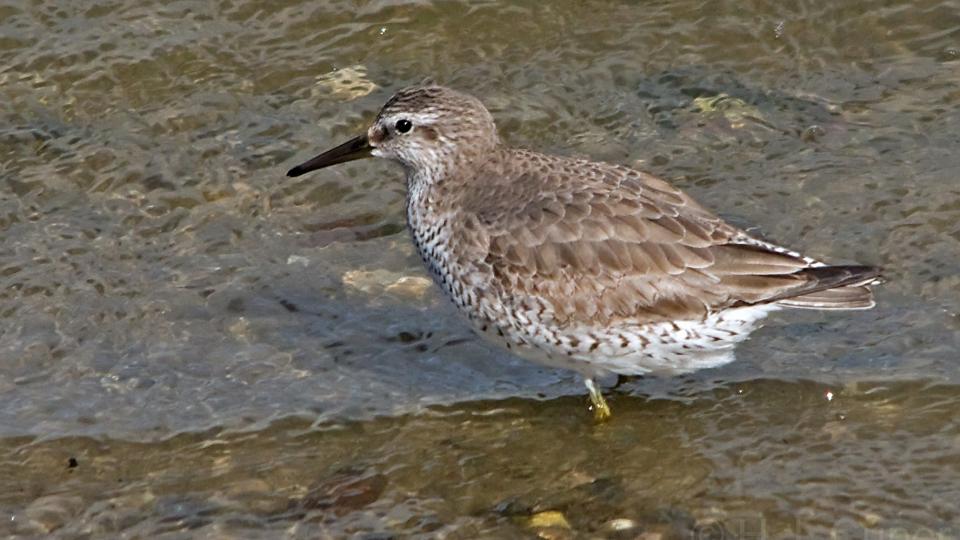
Red knot (Calidris canutus)
Red knot (Calidris canutus)
Photograph by Hennie Cuper, 2015.
Accessed via Flickr on 3 March 2021. Click here to view source.
 This work is licensed under a Creative Commons Attribution-NonCommercial 2.0 Generic License.
This work is licensed under a Creative Commons Attribution-NonCommercial 2.0 Generic License.
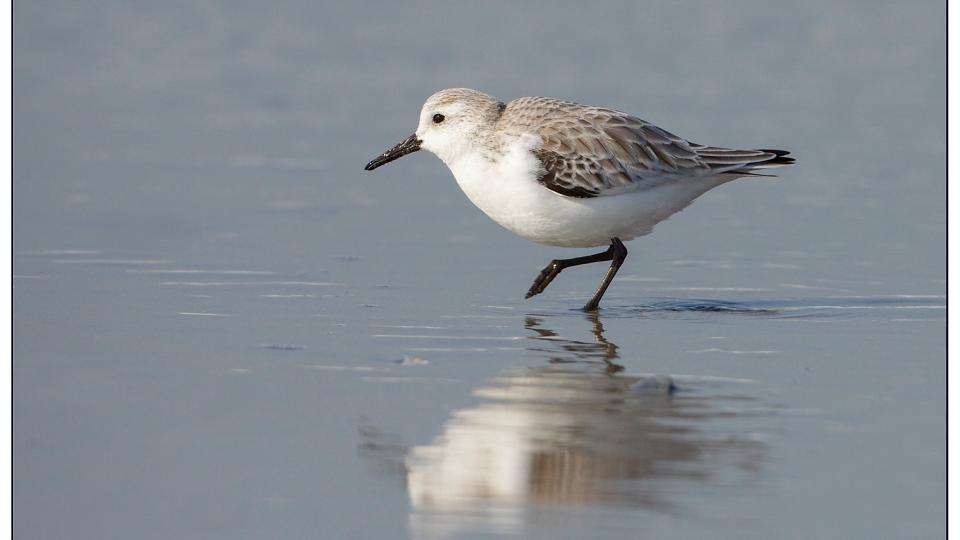
Sanderling (Calidris alba)
Sanderling (Calidris alba)
Photograph by Martha de Jong-Lantink, 2011.
Accessed via Flickr on 3 March 2021. Click here to view source.
Contemporary nature conservation in the Wadden Sea consciously and productively engages with the area’s dynamic geomorphological processes (Common Wadden Sea Secretariat 35). Still, the public and assessors of conservation management generally “want to hold onto what is” (Loon-Steensma 57).1 This idea is closely related to the disregard of history that is still prevalent today in human encounters with nature, especially in nature reserves. Dipesh Chakrabarty’s characterization of twentieth-century historians’ ideas about the environment still applies to the cultural imagination of nature, namely that human relations to the environment are “timeless” (204). In the Wadden Sea, this results in a tension between the perception of a landscape that is essentially stable, if nowadays at risk, and the dynamics of a space that faces stressors because of climate change in addition to its lived reality as a continuously changing space.
The climate crisis and the history of the Wadden Sea force us to reconsider this way of thinking, not just as scholars, but as a society. To accomplish this, we need new narratives and new imaginations of the landscape. One direction to look for these is literature. In Ed Leeflang’s Dutch poem “De drieteenstrandloper” (The Sanderling), the eponymous sandpiper becomes a symbol for the loss that the Wadden Sea faces. The sanderling, which in Low German is called “Keen Tied” (No time) because it seems to be in a perennial hurry, scuttles along the coast. Between the advancing and retreating waves of the sea, it
… leaves of his existence
the fleeting cuneiform,
in crooked running lines,
nearly quatrains.And by her forthright mopping
they are wiped out.
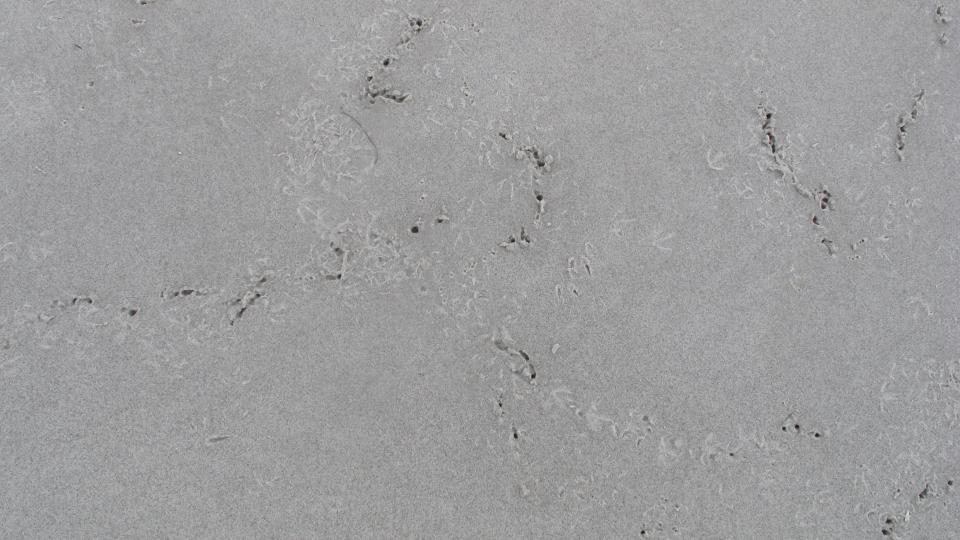
Sanderling footprints
Sanderling footprints
© R.Borcherding/BeachExplorer.org
Used by permission
The copyright holder reserves, or holds for their own use, all the rights provided by copyright law, such as distribution, performance, and creation of derivative works.
The poem exemplifies exactly the nonhuman agencies that traditional histories often ignore by anthropomorphizing the sandpiper and the sea. The bird’s footprints are likened to a poetic device, thus referencing a highly elaborate form of language, as well as the earliest known script. Yet, while cuneiform tablets are strengthened by the destructive forces of fire, meaning many have been well preserved for millennia, the sandpiper’s footprints last for mere seconds under the sea’s influence. The sea, in turn, does not so much wipe out the footprints as clean the shore, an explicitly intentional act. The fact that the stanza focused on the sea is cut short after only two lines, unlike the other stanzas which all have four, reinforces this destructive agency.
While highlighting the sanderling’s agency, the poem continues to put its power into perspective:
All traces of his scampering
must disappear, as if his instinct
to live on, unemphatically
got it wrong.
The sanderling, then, is bound to disappear, as was always its fate. In speaking about loss in the context of a bird who continually loses the ground beneath its feet and the marks it makes on the soil, this is a particularly resonant poem for the Anthropocene—a time in which we stand to lose so much, not least sandpipers, a family that includes a number of birds on the IUCN red list of threatened species. Still, the internal rhyme of the poem’s final two lines conveys a sense that although short lived, the sanderling’s fight for existence was not entirely misguided: it hints that there has been harmony, beauty, and a sense of belonging in its being.
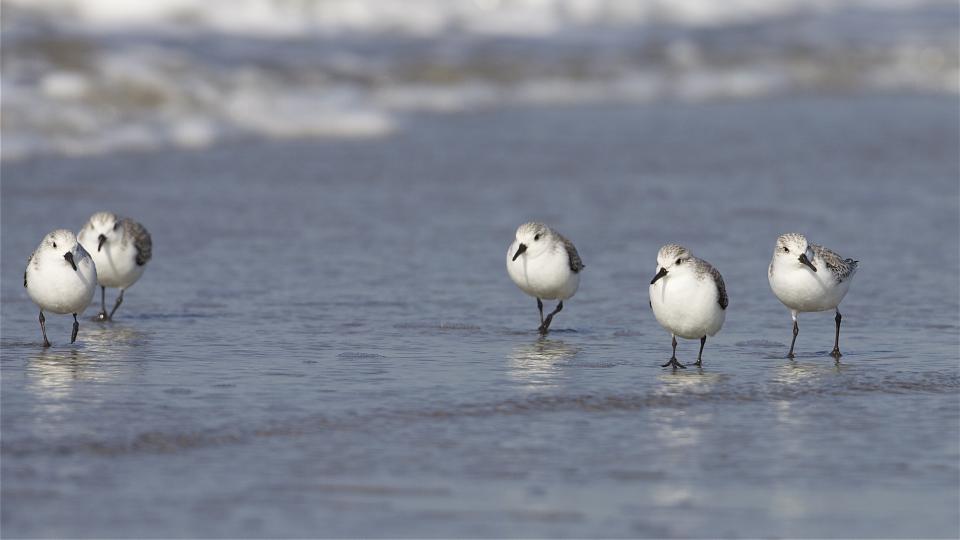
Five Sanderlings (Calidris alba)
Five Sanderlings (Calidris alba)
Photograph by Martha de Jong-Lantink, 2011.
Accessed via Flickr on 3 March 2021. Click here to view source.
 This work is licensed under a Creative Commons Attribution-NonCommercial-NoDerivs 2.0 Generic License.
This work is licensed under a Creative Commons Attribution-NonCommercial-NoDerivs 2.0 Generic License.
Literary scholar Bernhard Malkmus has argued that, in the Anthropocene, national parks can be sites that inspire an “attitude of letting go” (219).2 He writes that “[t]hey are a window into the (natural historical) past and therefore an important frame of reference for the formation of the future” (220).3 Much is changing in national parks around the world, including in the Wadden Sea. To face this change, we will not only have to adapt our conservation practices, but also our narratives, and act as much with imaginative force as with humbleness, and who can guide us here better than the humble sandpiper.
1 “[wij willen] graag vasthouden aan wat is.”
2 “Haltung des Loslassen-Könnens.”
3 “Sie sind ein Fenster in die (naturgeschichtliche) Vergangenheit und deswegen ein wichtiger Referenzrahmen für die Gestaltung der Zukunft.”
How to cite
de Smalen, Eveline. “Sandpipers and the Art of Letting Go: Narratives of Conservation in the Wadden Sea.” Environment & Society Portal, Arcadia (Spring 2021), no. 9. Rachel Carson Center for Environment and Society. doi:10.5282/rcc/9241.
ISSN 2199-3408
Environment & Society Portal, Arcadia
 This work is licensed under a Creative Commons Attribution 4.0 International License.
This work is licensed under a Creative Commons Attribution 4.0 International License.
2021 Eveline de Smalen
This refers only to the text and does not include any image rights.
Please click on an image to view its individual rights status
- Chakrabarty, Dipesh. “The Climate of History: Four Theses.” Critical Inquiry 35, no. 2 (2009): 197–222. doi:10.1086/596640.
- Common Wadden Sea Secretariat. Wadden Sea Plan 2010: Eleventh Trilateral Governmental Conference on the Protection of the Wadden Sea. Wilhelmshaven: Common Wadden Sea Secretariat, 2010. Accessed 18 January 2021.
- Loon-Steensma, Jantsje M. van. “Waddengebied in een veranderend klimaat: Going with the flow of vasthouden?” In Visies op de Wadden: Zes essays ten behoeve van de beleidsverkenning toekomstige rol en ambitie van het Rijk voor het Waddengebied, edited by Allert Bijleveld, Linde Egberts, Sierdjan Koster, Jantsje van Loon-Steensma, Jan Post, and Chris Seijger, 50–65. Leeuwarden: Waddenacademie, 2016.
- Malkmus, Bernhard. “Lernorte des Lebens: Nationalparks im Anthropozän.” In Urwald der Bayern: Geschichte, Politik und Natur im Nationalpark Bayerischer Wald, edited by Marco Heurich and Christof Mauch, 207–22. Göttingen: Vandenhoeck & Ruprecht, 2020.
- Wöbse, Anna-Katharina. “Space, Place, Land, and Sea: The ‘Ecological Discovery’ of the Global Wadden Sea.” In Spatializing the History of Ecology: Sites, Journeys, Mappings, edited by Raf de Bont and Jens Lachmund, 204–22. New York and Abingdon: Routledge, 2017.
- Wöbse, Anna-Katharina. “Knechtsand: A Site of Memory in Flux.” Global Environment 11 (2013): 160–83.
- Wöbse, Anna-Katharina, and Hans-Peter Ziemek. “Reinterpreting Nature: A Brief Environmental History of Trilateral Conservation in the Wadden Sea Region.” In Waddenland Outstanding: History, Landscape and Cultural Heritage of the Wadden Sea Region, edited by Linde Egberts and Meindert Schroor, 253–65. Amsterdam: Amsterdam University Press, 2018.


